Do you have stubborn acne or dandruff that won’t seem to go away? Do you have flakes around your nose, chin, eyebrows, or scalp? Do you have pus-filled whiteheads or itchy, red patches of skin?
If you answered yes to any of those questions, you might not be dealing with acne – you might have Malassezia and seborrhoeic dermatitis – also known as fungal acne and dandruff.
For a long time, I tried treating my acne with conventional methods – using harsh cleansers and creams with benzoyl peroxide and salicylic acid, only to find my acne coming back stronger than ever. If you’re like me, you probably tried everything from Retin-A to antibiotics to get rid of your acne, only to find your skin damaged and worse than before.
If this sounds like you, you’re not alone and it’s not your fault – typical acne treatments don’t improve fungal acne, they actually make it worse.
In my book, Unmasking Acne I detail how you can treat and cure fungal acne and seborrhoeic dermatitis internally, using diet, supplements, and natural antifungals, but in the meantime, I really wanted to share with you how one specific product, MCT oil, improved my decade-long dandruff and fungal acne in just two weeks, and why it’s so much better than traditional acne and dandruff products.
But first, I want to quickly cover what fungal acne is, and how it’s different than regular acne so that we can really understand why MCT oil works so well for both acne-prone skin and dandruff.
What is Malassezia and Fungal Acne?
Malassezia is a type of fungi that is naturally found on the skin. Everyone has Malassezia, and it’s actually necessary and beneficial in small amounts. Just like sebum oil (which usually takes the blame for bacterial, inflammatory, and hormonal acne,), Malassezia fungi isn’t evil – it’s too much Malassezia that’s the problem.
When the balance of Malassezia is thrown off on the skin or scalp, fungal infections and overgrowth can occur, leading to tons of different skin conditions, including fungal acne, seborrhoeic dermatitis (dandruff), psoriasis, and eczema. Basically, a fungal infection can cause just about every skin issue out there, so it’s super important to keep Malassezia levels regulated and check to make sure the current skincare products you are using will not cause the yeast to proliferate out of control.
While many people’s skin has no problem naturally managing Malassezia levels, individuals with a compromised immune system, skin microbiome, or gut microbiome tend to have a much harder time managing Malassezia and are much more likely to have fungal acne and dandruff.
The underlying health issues that lead to Malassezia overgrowth can arise for a few reasons: the use of oral and topical antibiotics is a big one, along with eating an inflammatory diet. If you’ve used topical acne products or cleansers in the past and found yourself with fungal acne, it could be due to the fact that harsh acne products tend to disrupt the natural skin microbiome and act as antibiotics, leaving the skin too damaged and weak to fight off excess Malassezia. It’s one more reason why I strongly advocate for tackling acne through your diet, lifestyle, and supplements.
Before I talk about how I improved my fungal acne and dandruff with MCT oil and other natural antifungals, let’s go over the signs and symptoms of Malassezia overgrowth so that you can identify the proper treatments and methods for your specific skin.
Signs and Symptoms of Fungal Acne and Malassezia
If you’re just trying to get rid of dandruff with MCT oil, skip this section – it’s really easy to tell if you have dandruff, and regardless of whether it’s caused by dry skin or Malassezia fungus, the products I recommend below can fix it.
Fungal acne, on the other hand, is a little trickier to diagnose. It’s much different than regular acne – in fact, it’s technically not even acne at all, it just looks like acne and caused by fungi, so we call it fungal acne.
The most surefire way to tell if you have fungal acne is to check with a dermatologist – unfortunately, many of us (me included!) don’t have easy or affordable access to a dermatologist.
Luckily, it’s pretty easy to tell if you have fungal acne. These are the most common signs and symptoms:
- Whiteheads near the lips, nose, eyebrows, or jawline
- White, flakey substances near the nose
- Dandruff or flakes in the hair
- Red, pus-filled pimples
- Redness around nose and lips
- Acne that doesn’t seem to respond to conventional cleansers, creams, or treatments
Now you don’t want to jump to conclusions too quickly, but if you have had acne for a while and regular acne products don’t seem to work, you may have fungal acne. Still, even if you have regular bacterial acne and not fungal acne, the protocol I have below is a lot safer for your skin than most routines out there, and MCT oil can help both kinds of acne.
What is MCT Oil and Why It Helps With Acne and Dandruff
Basically, MCT oil is coconut oil with all the yeast-feeding properties removed.
On its own, coconut oil is an acne-killing machine – in fact, one study found that coconut oil was three times more effective than benzoyl peroxide, the most common ingredient in over-the-counter acne products, at killing acne bacteria.
Unfortunately, coconut oil is a nightmare for fungal acne and dandruff because it contains a large amount of saturated fatty acids called lauric acid. Malassezia, the fungus behind both fungal acne and seborrhoeic dermatitis-driven dandruff, feeds off of lauric acid. So while coconut oil is great for most acne, it’s not great for fungal acne.
While coconut oil is mostly lauric acid, which feeds acne and dandruff-causing bacteria, MCT oil (if you buy the right kind) is purely caprylic acid without the lauric acid, which means you’re left with pure fungus-fighting oil.
As an added bonus, while coconut oil is comedogenic, meaning it can clog pores (which we all know can lead to acne infections), MCT oil is non-comedogenic and extremely moisturizing. It leaves both the skin and the scalp moisturized and protected.
You can buy any kind of MCT oil you want as long as it’s pure caprylic and capric acid with no lauric acid. Check the ingredients list and make sure there is no lauric acid before you buy it – otherwise, you’ll be feeding your fungal acne and dandruff, not getting rid of it.
The best MCT oil that I personally use in my routine is the BUBS Natural MCT Oil Powder. It’s formulated from 100% virgin pressed coconut oil, and is made with 70% caprylic acid and 30% capric acid (and no lauric acid) – which, as we’ve discussed, is key when looking for the right MCT oil for fighting dandruff and acne. The clean, high-quality formula is also free of gluten, soy, nuts, corn, and GMOs.
The BUBS Natural product comes in a dissolvable powder, which particularly makes it much easier to travel with compared to traditional liquid MCT oils. Simply dissolve it in water and you are ready to go. For anyone looking to harness the additional benefits of MCT oil (such as boosting energy and improving mental clarity), you can also dissolve the powder into other beverages (such as coffee or smoothies) to add it to your diet.
Best MCT Oil:
Bubs Naturals – MCT Oil Powder
The BUBS MCT Oil Powder has a high-quality formula that contains a perfect balance of caprylic and capric acids, making it an ideal choice for those looking to fight acne and/or dandruff.
GoodGlow Score
No Unnecessary Fillers
Free of nuts, gluten, soy, corn, flavorings, and GMOs.
No Lauric Acid
Formula is completely free of lauric acid, so there’s no need to worry about it triggering dandruff or acne.
Balanced Caprylic and Capric Acids
Formula contains 70% caprylic acid and 30% capric acid, which is an ideal balance for treating acne and dandruff.
Easy to Use
Dissolvable powder quickly mixes with water for easy application.
How I use MCT Oil for Acne and Dandruff
There’s no blueprint on the perfect way to use it – you’ll need to experiment and find your own sweet spot, but I’ve found that generally speaking, the less I wash my face and hair the better.
Here’s the summary of my routine:
- Once a day in the afternoon, I’ll massage about a tablespoon or two (enough for a thin layer) of MCT oil to both my skin and my scalp.
- Let the MCT oil sit for 15 minutes or so – sometimes, I’ll let it sit for an hour or two
- Wash your face with lukewarm or cold water (hot water can dry your skin and kill good bacteria), and, if you want, use a microfiber cloth to wipe the oil off
- 1-2 times a week, I will use MCT oil with organic tea tree oil. I use the same amount of MCT oil, and then add 2-3 drops of tea tree oil for my entire scalp and face – tea tree oil is very potent – less is more!
I will also use raw honey masks once or twice a week, especially if I’m seeing a lot of redness or flakes around my nose. Unlike many other fungal infections, Malassezia fungi does not feed on sugar or carbohydrates – which means raw honey (which has lots of sugar in it) is generally safe for fungal acne. Honey is a natural antibacterial and antifungal, and I find that it helps quite a bit with my acne. Right now I’m using manuka honey, but honestly, I think that any kind of raw, organic honey would do the trick (just really make sure you get raw honey).
For my hair and skin, I will also use raw apple cider vinegar once or twice a week to wash excess oil out and tone my skin. Apple cider vinegar is a natural antifungal and antibacterial. I pore a mixture of a few tablespoons of ACV mixed with 2 cups of water and leave it on my scalp and face for 3-5 minutes. It leaves the skin surprisingly moisturized and clean.
If you’re like me, you’re probably thinking that this is crazy. After all, doesn’t oily skin cause acne and dandruff? Trust me, this is what I thought too, and I don’t blame you – after all, we’ve been told by our parents and dermatologists that damaging soaps and cleansers are the secrets to clear skin for decades. But trust me, they’re not. Here’s why I don’t use them…
Why I Don’t Use Soap, Acne Products, or Dandruff Shampoos
I would advise against not using soap or shampoo to get rid of fungal acne and dandruff for a few reasons.
First off, soap and acne products are extremely drying and damaging to the skin microbiome – in fact, most of our skin is too clean, and despite what your dermatologist told you, acne, especially fungal acne, is not caused by grimy or oily skin. In fact, if you have acne, your skin doesn’t have enough beneficial oil and bacteria to fight off fungus and acne bacteria. By stripping your skin and scalp of its necessary, healthy, moisturizing oils, your skin will compensate by pumping out more sebum oil. Both acne bacteria and Malassezia fungi thrive on sebum oil.
If you have fungal acne, benzoyl peroxide, the active ingredient in most acne cleansers, is only going to make it worse by damaging your gut microbiome, increasing overall sebum oil production (which feeds fungal acne), and drying out the skin. Fungal acne does not respond to conventional acne treatments because it isn’t caused by bacterial infections. This is why gentle, glycerin-based cleansers are best for fungal acne when you want to wash the normal dirt and grime off of your face.
The same goes for shampoo, especially prescription and over-the-counter dandruff shampoo. While it’s effective at getting rid of dandruff temporarily, it almost always results in more dandruff for two reasons: the fungus on the scalp can adapt to it, and it makes my scalp extremely dry, which can lead to flakey skin and thin, dry, damaged hair.
Trust me, you might break out or find your dandruff getting worse when you first start using MCT oil, but stick with it for at least 2 weeks and you’ll really thank yourself.
When I first stopped using soap, my skin and scalp was a nightmare, but slowly and surely, it started to get considerably better as the days went on.
Closing Thoughts
I know it might seem crazy to put MCT oil, raw honey, and tea tree oil on your face, but trust me – if you have fungal acne or dandruff, the problem usually isn’t too much bacteria and sebum oil, it’s not enough.
Your skin needs help to balance out the Malassezia fungi on your skin, and it can’t do that when you’re bombarding it with antibiotics and harsh cleansers. On the other hand, MCT oil and other natural antifungals kill acne bacteria and Malassezia without damaging or drying the skin, leaving your skin with less acne, less dandruff, and more good bacteria to prevent it from happening again in the future.
I’m not saying MCT oil is a cure-all for acne or dandruff – but even after eating a healthy, acne-fighting diet, I still found myself with some annoying dandruff and fungal acne around my nose – MCT oil was the only thing that really helped.
If you’re really looking for that extra edge against fungal ance or would prefer to treat it at the source, check out my new book, Unmasking Acne, which has a whole chapter dedicated to a Fungal Acne Protocol.
I urge you to try it out and let me know how it goes in the comments below.
Frequently Asked Questions
Lauric acid is a saturated fat found in many vegetable fats such as coconut oil and palm kernels.
Fungal acne is typically filled with dark-colored, puss and is extremely itchy. Fungal acne can be found on the face, scalp, arms, and chest.

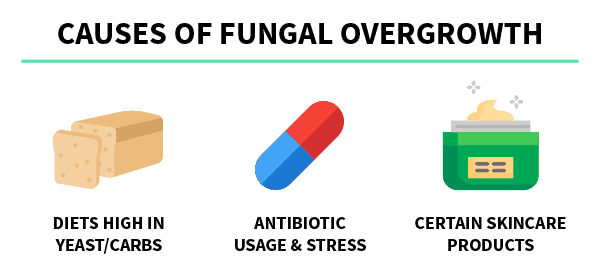

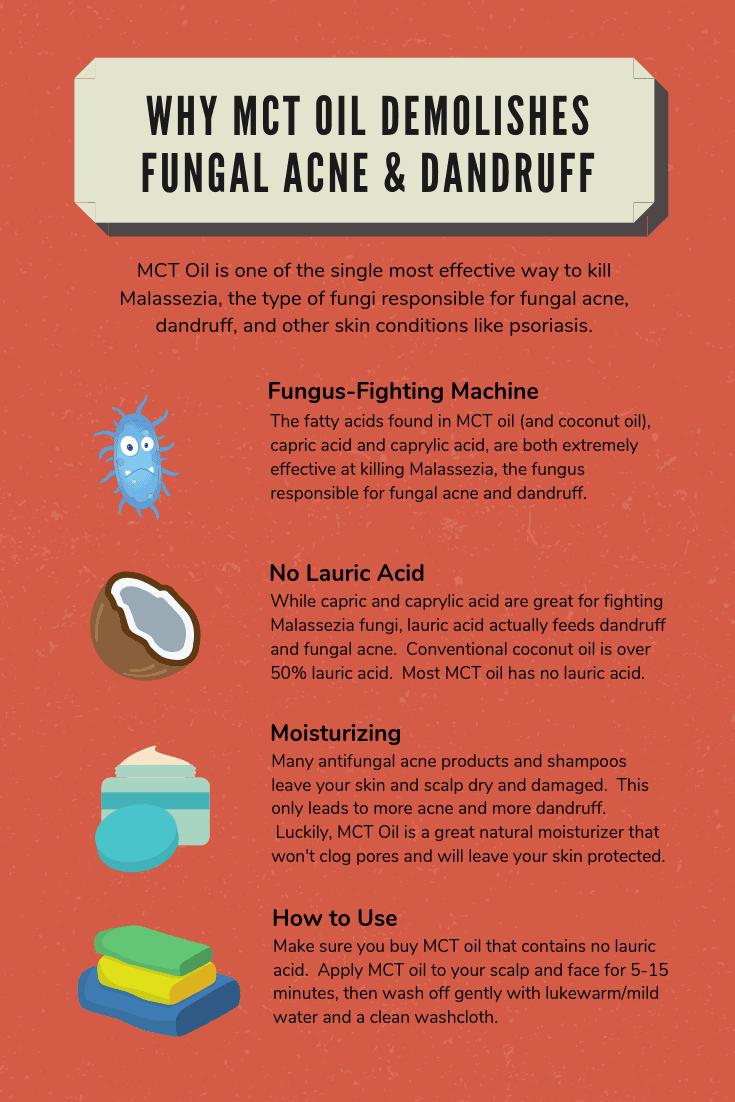
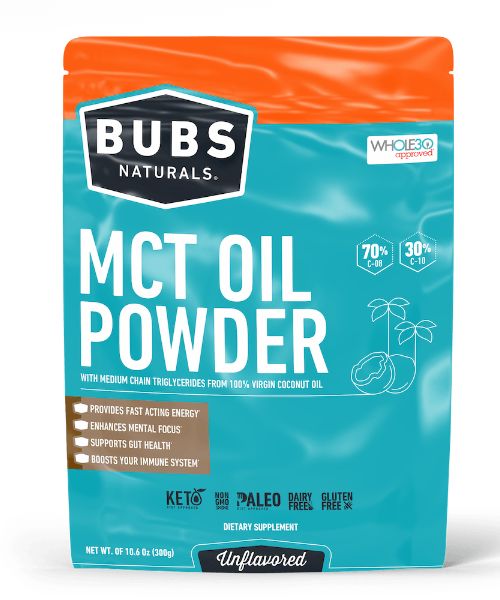
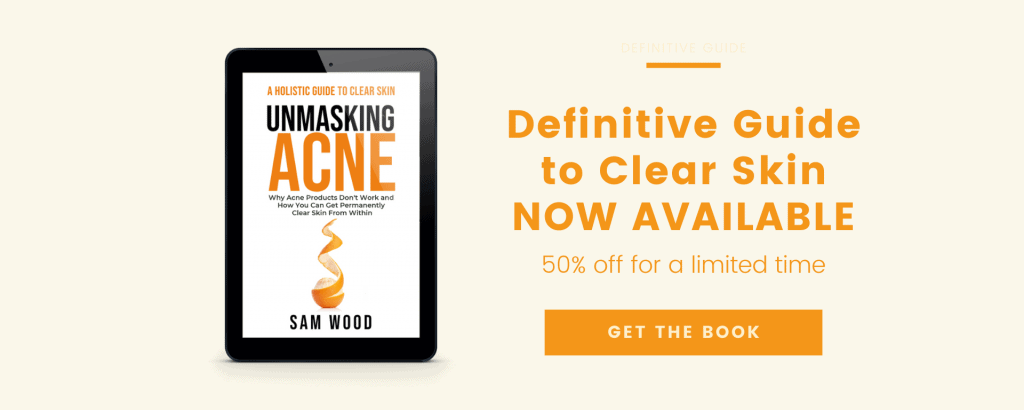
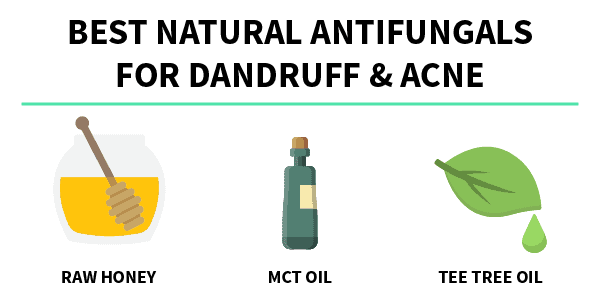

Hi,
I think I have fungal acne + eczema on my hands caused by malasezzia. I’m trying to find natural solutions for my skin care products however there aren’t many + I would also love to find some which are eco friendly. You are the only blog I found that doesn’t recommend all these toxic skin care products. However, I dont seem to understand, do you use ACV instead of your shampoo and body wash? It just seems a little weird and I’m not sure I have a good grasp of the idea in that.
What do you do for body wash ??
Contrary to popular belief, you don’t NEED body wash. Nobody does! In fact, most of the crap that’s being sold to us is not only unnecessary, it’s also harmful both to you, and the environment. You could easily get clean using Dead Sea or Epsom salt alone, but multi-billion dollar industries wouldn’t make much money if you did!
So they make more unnecessary crap!
I having been using mct C8 oil on my skin for a week and it’s gotten considerably worse. Do you think it’s a purge or something else?? PLEASE REPOND. I have googled everything!!! I use it as an ocm and mix a few drops in my already fungal acne safe moisurizer
This is just a guess…but could it be because your MCT C8 oil is palm-derived rather than the coconut-derived variety that Sam mentions?
Or could you be using other skincare or makeup products that are causing a problem?
I’ve found The Ordinary’s inexpensive Niacinamide + Zinc super helpful for actually reducing the constant congestion in my pores (and therefore their size)! And sulfur (such as in Bye Bye Blemish) works great as a spot treatment (just don’t overuse as it’s drying)!
If I had sebderm in the past, do you think sauna use is harmful in making it ‘pop’ up again ? In the past when I had sebderm I used the sauna which worsened the condition….Thus, any link between sauna use and sebderm?
It’s covered in the article. Initially there may be an increase in symptoms but if you stick it out, you will see results.
Did you read Sam Wood’s entire post? Towards the end he warns that your skin and dandruff will probably get worse once you start using MCT oil, but if you can stick with it for 2 weeks, it’ll clear up.
I think it gets worse before getting better the same way that symptoms of Candida overgrowth gets worse before getting better. When one takes meds, supplements and/or changes their diet to eliminate Candida overgrowth, they often experience “die-off” symptoms. This is caused by the body’s reaction to the toxins being released when yeast breaks down from the treatment. These little buggers don’t want us to kick them out of, or off our bodies. Think about it from their perspective. If they fight back and make you more miserable, then maybe you’ll stop trying to eliminate them! So, give it 2 weeks at least before giving up entirely. There are lots of people who have successfully eliminated these issues with MCT oil.
I will try it and update it here. I have MCT oil for ket but now I will try to use it on my face
also, I will stop using hot water!
Im using a full tablespoon of the oil for my face is it too much? And should I clean my face before I do it I usually just put it directly since I don’t use make up?.
The brands I’m using are north coast mtc oil and brain Mtc oil which one do you recommend for this?
My skin is starting to balance it self out but I am braking out a bit more than usual around the mouth area is this normal? I also started consuming it. Thank you very informative webpage you have.
From what I’ve read, I think you skip the ordinary cleansing method and use MCT oil as a replacement.
Washing your face with an ordinary cleanser before applying the MCT oil, is like taking one step backward before taking one step forward. You won’t go very far! 😉
I’ve had the absolute worst year of my life. June 2019 I caught scabies from my daughter & grandkids 5x until Oct. 2 wks later my became infested with whole body demodex mites (face mites most of us have) which I still struggle with. Wait not over yet…. 2 wks ago my whole body broke out with fungal acne & noticed malassezia furfur (tinea versicolor) which probably happened due to using argon & castor oils along with essential oils.
I began using MCT along with essential oils, ACV, dandruff shampoo & 2% Salicylic acid. All the fungal acne is completely dried out, not sure but I’m hoping the furfur is subsiding, the itching has lessened. As for the demodex mites they are still a work in progress.
I feel blessed the demodex nor the fungi ever attacked my face.
Keep using the MCT as well as the ACV. They work well. As usual I didn’t to go the MD bc of the harsh meds.
Thank you for this; I’m curious what do you use for body wash and shampoo? Also to the person who commented above please update! And also let us know if you continued after a week of hell lol
Again, shampoo and body wash is unnecessary. That’s what Sam Wood, the writer of this post is trying to convey. He’s saying that shampoos and soaps are going to harm your skin instead of help it in the long run. Anyone whose had dandruff or fungal acne knows that using the shampoos and soaps recommended for these issues ONLY offers temporarily relief, but it doesn’t fix the problem. In fact they only add to the problem, which is an imbalance of your skin’s microbiome.
We are on the 14th day of using MCT oil on my son and it does seem better but not completely gone. Do you recommend just using MCT oil and no other cleanser? I think he has the fungal acne on his back and regular acne on his face.
I found that using a witch hazel natural toner (Thayers) instead of soap extremely beneficial–my little bumps have pretty much disappeared, I only use an spf 30 moisturizer and pretty much set.
I’ll try some of these tricks for my scalp and ears though! Thanks.
This is my first time pay a quick visit at here and i am truly pleassant to read everthing at single place. Vilhelmina Ulrick Tuneberg
Thank you! There is so little information on how to naturally heal this yeast – everyone is focused on candida instead.
Do you know if a pure mineral derived caprylic acid such as this one https://www.amazon.com/gp/product/B0029QK1M0/ref=ppx_yo_dt_b_asin_title_o05_s00?ie=UTF8&psc=1 also have a similar effect on reducing malessezia? I have heard it’s better to do the time release. Thanks!
Hi CC!
Glad you enjoyed the post 🙂
I just looked at the mineral-derived caprylic acid you referenced and it should work great for combatting yeast. I use a very similar formula and it works great.
Cheers!
If I had sebderm in the past, do you think sauna use is harmful in making it ‘pop’ up again ? In the past when I had sebderm I used the sauna which worsened the condition….Thus, any link between sauna use and sebderm?
4 weeks in and completely flake free.
I’m talking about bleeding scalp, hair loss, the pain a sensitivity. All Gone!
I even have new baby hair growth.
I am black and my hair is natural and the only challenge is that MCT oil is not enough hydration for my hair type.
I’m curious, what humectant or hydrating product can I mix it with that is Laurie acid free to make sure my hair isn’t brittle. Enjoying my scalp so much I am too afraid to try anything else.
I’m in the exact same boat as Noahelle. Black, natural hair and have suffered from seborrheic dermatitis for so many years, I am glad it is responding to the MCT oil. I have noticed my hair is getting dry and brittle, and seemingly none of my regular products are suitable (why so much coconut oil!). Any ideas of natural moisturising products that won’t feed the Malassezia?
I found something!!
It’s a tad bit on the pricier side and smells like it came straight from a cocoa plant itself but my hair loves it and I still avoid my scalp just to be safe.
Qhemet Biologics Cocoa Tree Detangling Ghee
I’ve been using a spray bottle full of water mixed with dead sea salt and leaving it on 10 ro 15 minutes before rinsing it off in the shower. I have been using Jason aloe vera shampoo even though the writer suggests none whatsoever and slathering my head with aloe vera gel. Try to find as pure as you can and without alcohol. I justvadded the mct oil. I’ll reply back in a few weeks after adding mct.
I don’t know and haven’t researched but I’m looking at roseship oil as a moisturizer
This information is so helpful. I also have the question of what shampoo and body wash is good to use in addition to ACV and MCT oil without Lauric Acid.
Hi Sam,
I’ve suffered from seb derm since I was in HS. Would you recommend I stop consuming coconut oil due to the lauric acid? I don’t apply it to my skin for several reasons, but is consumption ok? I haven’t tried MCT oil yet, but I’ll give it a shot. Also, do you know if oral antifungal supplements would help? (Ex. Fluconazole) Thank you!
Loved your article! I’m just a little confused u say not to use Lauric acid but your link shows it has 3.8g in the MCT oil? Also what are your thoughts on roseship oil at nighttime or just in general or combined with the Mct oil
Thanks!
I loved this article but I have a question…confirming that you recommend Onnit MCT Oil because the link goes to a different brand. I want to start right away but not sure which to purchase. I have Malassezia, I just don’t know what kind. Due to my immune system & nutritional deficiencies (I’m 77 years old) I also have Demodex mites, another natural parasite, out of control. My Malassezia presents on my scalp, back and mid body. It feels very similar to that movement sensation from Demodex. I don’t have acne. But I do have that stabbing sensation & often terrible itching.
You can check ingredients with this form to ensure you aren’t feeding Malassezia with any ingredients that you may use on your skin or scalp.
https://www.sezia.co/
Surely you use some kind of shampoo to shampoo out the mct from you hair? Which shampoo would be fungal safe to get the oil out?
do any of you guys know some hydrating products for hair because in the process of treating malassezia my hair is totally dried out , before that i had really smooth textured silky hair .
Hello! I said using the Mct oil you recommended now I’m experiencing tiny bumps not to bad but they are a little itchy not to much. My skin history is long but long story short I had tons of small bumps on my forehead and cheeks. I wanted to know if my reaction is something your experienced after 2 days.